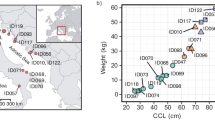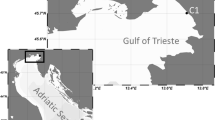Abstract
We isolated 99 yeast strains, including 40 red yeasts, from benthic animals and sediments collected from the deep-sea floor in various areas in the northwest Pacific Ocean. Comparing the yeast isolates from animals and sediments collected from shallow locations, the proportion of red yeasts differed considerably, comprising 81.5% and 10.6% of the isolates from animals and sediments, respectively. All of the red yeast isolates belonged to the genera Rhodotorula and Sporobolomyces. On the basis of morphological and physiological characteristics, the isolates were identified as R. aurantiaca, R. glutinis, R. minuta and R. mucilaginosa of the genus Rhodotorula, and S. salmonicolor and S. shibatanus of the genus Sporobolomyces. Only R. glutinis and R. mucilaginosa were isolated from sediments. All of the others were isolated from animal sources. Phylogenetic analyses based on internal transcribed spacer (ITS) regions and 5.8S rRNA gene sequences allowed us to establish the precise taxonomic placement of each of the isolates and thereby investigate the intraspecific relationships among the isolates. Twenty-two strains identified as members of R. glutinis, which showed a wide distribution in the deep-sea, and five isolates identified as R. minuta, which were isolated only from benthic animals, showed substantial heterogeneity within the species. The isolates phenotypically identified as Sporobolomyces species and R. mucilaginosa phylogenetically occupied the placements corresponding to these species. Some strains assigned to known species on the basis of phenotypic features should be regarded as new species as suggested by the results of molecular analysis.
Similar content being viewed by others
References
Adachi J & Hasegawa M (1996) Molphy version 2.3: programs in molecular phylogenetics based on maximum likelihood. In: Computer science monographs, no. 28. The Institute of Statistical Mathematics, Tokyo
Boekhout T (1998) Diagnostic descriptions and key to presently accepted heterobasidiomycetous genera. In: Kurtzman CP & Fell JW (Eds) The yeasts: a taxonomic study, fourth revised and enlarged edition (pp 627-634). Elsevier Science Publishers B.V., Amsterdam, Netherlands
Fell JW (1976) Yeasts in oceanic regions. In: Jones EBG (Ed) Recent advances in aquatic mycology (pp 93-124). Elek Science, London, United Kingdom
Fell JW & Statzell-Tallman A (1998) Rhodotorula. In: Kurtzman CP & Fell JW (Eds) The yeasts: a taxonomic study, fourth revised and enlarged edition (pp 800-827). Elsevier Science Publishers B.V., Amsterdam, Netherlands
Fell JW, Boekhout T & Freshwater DW (1995) The role of nucleotide sequence analysis in the systematics of the yeast genera Cryptococcus and Rhodotorula. Stud. Mycol. 38: 129-146
Fell JW, Statzell-Tallman A, Lutz MJ & Kurtzman CP (1992) Partial rRNA sequences in marine yeasts: a model for identification of marine eukaryotes. Mol. Mar. Biol. Biotechnol. 1: 175-186
Fell JW, Boekhout T, Fonseca A, Scorzetti G & Statzell-Tallman A (2000) Biodiversity and systematics of basidiomycetous yeasts as determined by large-subunit rDNA D1/D2 domain sequence analysis. Int. J. Syst. Evol. Microbiol. 50: 1351-1371
Felsenstein J (1985) Confidence limit on phylogenies: an approach using the bootstrap. Evolution 39: 783-791
Felsenstein J (1995) PHYLIP: phylogenetic inference package, version 3.57c. University of Washington, Seattle
Hagler AN & Ahearn DG (1987) Ecology of aquatic yeasts. In: Rose AH & Harrison JS (Eds) The yeasts, second edition, vol. 1 (pp181-205). Academic Press, London, United Kingdom
Hernandez-Saavedra NY, Hernandez-Saavedra D & Ochoa JL (1992) Distribution of Sporobolomyces (Kluyver et van Niel) genus in the western coast of Baja California Sur, Mexico. System. Appl. Microbiol. 15: 319-322
Kato C, Li L, Nogi Y, Nakamura Y, Tamaoka J & Horikoshi K (1998) Extremely barophilic bacteria isolated from the Mariana Trench, Challenger Deep, at a depth of 11,000 meters. Appl. Environ. Microbiol. 64: 1510-1513
Kishino H, Miyata T & Hasegawa M (1990) Maximum likelihood inference of protein phylogeny, and the origin of chloroplasts. J. Mol. Evol. 31: 151-160
Komagata K & Nakase T (1967) Reitoshokuhin no biseibutsu ni kansuru kenkyu. V. Shihan reitoshokuhin yori bunri shita kobo no seijo (Microbiological studies on frozen foods) (in Japanese). Shokuhin Eiseigaku Zasshi 8: 53-57
Lachance MA & Starmer WT (1998) Ecology and yeasts. In: Kurtzman CP & Fell JW (Eds) The yeasts: a taxonomic study, fourth revised and enlarged edition (pp 21-30). Elsevier Science Publishers B.V., Amsterdam, Netherlands
Morris EO (1968) Yeasts of marine origin. Oceanogr. Mar. Biol. Ann. Rev. 6: 201-230
Nakase T & Suzuki M (1986) Bullera megalospora, a new species of yeast forming large ballistospores isolated from dead leaves of Oryza sativa, Miscanthus sinensis and Sasa sp. in Japan. J. Gen. Appl. Microbiol. 32: 225-240
Saitou N & Nei M (1987) The neighbor-joining method: a new method for reconstructing phylogenetic trees. Mol. Biol. Evol. 4: 406-425
Spencer JFT & Spencer DM (1997) Ecology: where yeasts live. In: Spencer JFT & Spencer DM (Eds) Yeasts in natural and artificial habitats (pp 33-57). Springer-Verlag, Berlin, Germany
Takami H, Inoue A, Fuji F & Horikoshi K (1997) Microbial flora in the deepest sea mud of the Mariana Trench. FEMS Microbiol. Lett. 152: 279-285
Takami H, Kobata K, Nagahama T, Kobayashi H, Inoue A & Horikoshi K (1999) Distribution of extremophiles in deep-sea sites located near the south part of Japan. Extremophiles. 3: 97-102
Thompson JD, Higgins DG & Gibson TJ (1994) ClustalW: improving the sensitivity of progressive multiple sequence alignments through sequence weighting, positions-specific gap penalties and weight matrix choice. Nucleic Acids Res. 22: 4673-4680
van derWalt JP & Yarrow D (1984) Methods for the isolation, maintenance, classification and identification of yeasts. In: Kreger-van Rij NJW (Ed) The yeasts: a taxonomic study, 3rd edition (pp 45-104). Elsevier Science Publishers B.V., Amsterdam, Netherlands
White TJ, Bruns T, Lee S & Taylor JW (1990) Amplification and direct sequencing of fungal ribosomal RNA genes for phylogenetics. In: Innis M, Gelfand D, Sninsky JJ & White TJ (Eds) PCR protocols (pp 315-322). Academic Press, San Diego, California
Yamasato K, Goto S, Ohwada K, Okuno D, Araki H & Iizuka H (1974) Yeasts from the Pacific Ocean. J. Gen. Appl. Microbiol., 20: 289-307
Author information
Authors and Affiliations
Corresponding author
Rights and permissions
About this article
Cite this article
Nagahama, T., Hamamoto, M., Nakase, T. et al. Distribution and identification of red yeasts in deep-sea environments around the northwest Pacific Ocean. Antonie Van Leeuwenhoek 80, 101–110 (2001). https://doi.org/10.1023/A:1012270503751
Issue Date:
DOI: https://doi.org/10.1023/A:1012270503751




